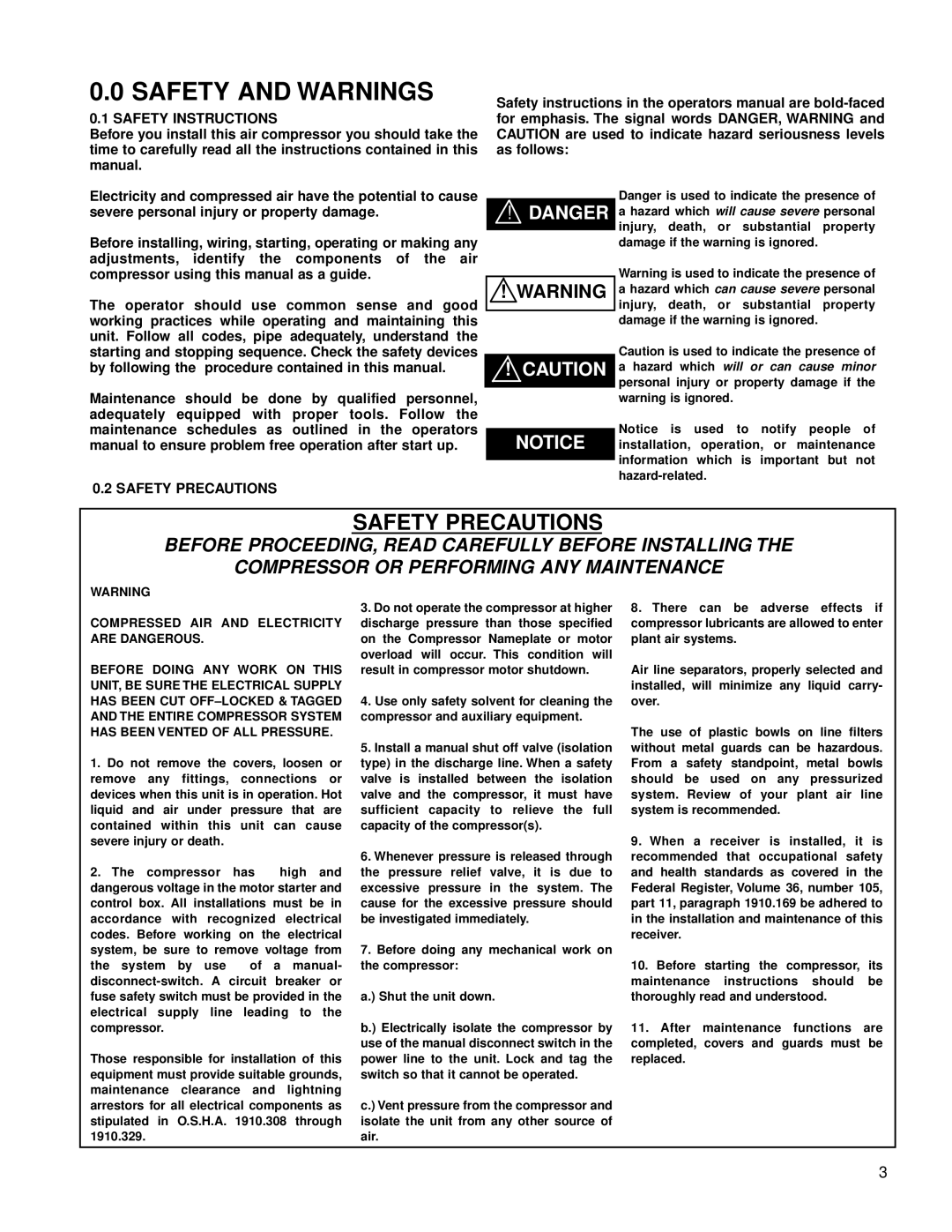
0.0SAFETY AND WARNINGS
0.1SAFETY INSTRUCTIONS
Before you install this air compressor you should take the time to carefully read all the instructions contained in this manual.
Electricity and compressed air have the potential to cause severe personal injury or property damage.
Before installing, wiring, starting, operating or making any adjustments, identify the components of the air compressor using this manual as a guide.
The operator should use common sense and good working practices while operating and maintaining this unit. Follow all codes, pipe adequately, understand the starting and stopping sequence. Check the safety devices by following the procedure contained in this manual.
Maintenance should be done by qualified personnel, adequately equipped with proper tools. Follow the maintenance schedules as outlined in the operators manual to ensure problem free operation after start up.
0.2 SAFETY PRECAUTIONS
Safety instructions in the operators manual are
Danger is used to indicate the presence of
D! DANGER a hazard which will cause severe personal injury, death, or substantial property
damage if the warning is ignored.
Warning is used to indicate the presence of
!WARNING a hazard which can cause severe personal injury, death, or substantial property
damage if the warning is ignored.
Caution is used to indicate the presence of
!CAUTION a hazard which will or can cause minor personal injury or property damage if the
warning is ignored.
Notice is used to notify people of
NOTICE installation, operation, or maintenance information which is important but not
SAFETY PRECAUTIONS
BEFORE PROCEEDING, READ CAREFULLY BEFORE INSTALLING THE
COMPRESSOR OR PERFORMING ANY MAINTENANCE
WARNING
COMPRESSED AIR AND ELECTRICITY ARE DANGEROUS.
BEFORE DOING ANY WORK ON THIS UNIT, BE SURE THE ELECTRICAL SUPPLY HAS BEEN CUT
1.Do not remove the covers, loosen or remove any fittings, connections or devices when this unit is in operation. Hot liquid and air under pressure that are contained within this unit can cause severe injury or death.
2. The compressor has high and dangerous voltage in the motor starter and control box. All installations must be in accordance with recognized electrical codes. Before working on the electrical system, be sure to remove voltage from
the system by use of a manual-
Those responsible for installation of this equipment must provide suitable grounds, maintenance clearance and lightning arrestors for all electrical components as stipulated in O.S.H.A. 1910.308 through 1910.329.
3.Do not operate the compressor at higher discharge pressure than those specified on the Compressor Nameplate or motor overload will occur. This condition will result in compressor motor shutdown.
4.Use only safety solvent for cleaning the compressor and auxiliary equipment.
5.Install a manual shut off valve (isolation type) in the discharge line. When a safety valve is installed between the isolation valve and the compressor, it must have sufficient capacity to relieve the full capacity of the compressor(s).
6.Whenever pressure is released through the pressure relief valve, it is due to excessive pressure in the system. The cause for the excessive pressure should be investigated immediately.
7.Before doing any mechanical work on the compressor:
a.) Shut the unit down.
b.) Electrically isolate the compressor by use of the manual disconnect switch in the power line to the unit. Lock and tag the switch so that it cannot be operated.
c.) Vent pressure from the compressor and isolate the unit from any other source of air.
8.There can be adverse effects if compressor lubricants are allowed to enter plant air systems.
Air line separators, properly selected and installed, will minimize any liquid carry- over.
The use of plastic bowls on line filters without metal guards can be hazardous. From a safety standpoint, metal bowls should be used on any pressurized system. Review of your plant air line system is recommended.
9.When a receiver is installed, it is recommended that occupational safety and health standards as covered in the Federal Register, Volume 36, number 105, part 11, paragraph 1910.169 be adhered to in the installation and maintenance of this receiver.
10.Before starting the compressor, its maintenance instructions should be thoroughly read and understood.
11.After maintenance functions are completed, covers and guards must be replaced.
3
